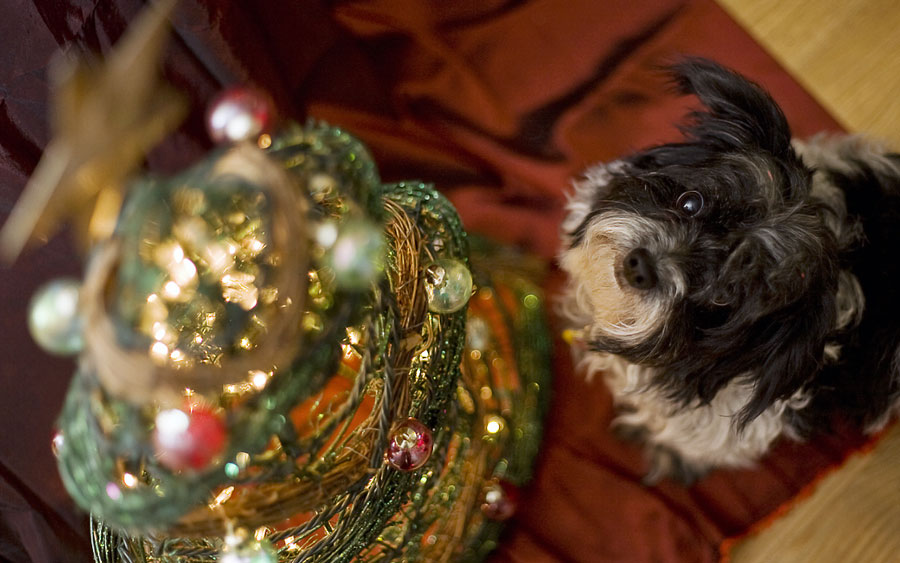Veterinary experts warn holiday joy can present animal health hazards

Decorations and holiday treats may help make the season bright, but they can also cause problems for household pets, say experts in the Virginia-Maryland Regional College of Veterinary Medicine at Virginia Tech.
A few precautions can help make sure a family's holiday spirit isn't dampened by the untimely -- and preventable -- illness or injury of a beloved dog or cat.
One of the most common problems during the holiday season is dietary indiscretion -- dogs and cats love to be around all the holiday food, and may experience a variety of gastrointestinal disturbances if they get treats, or steal food off the counters or from the garbage can. A tidbit of bland table food may be acceptable for an occasional holiday treat, but pets should be monitored carefully to keep them out of trouble.
Many problems also occur when curious pets ingest foreign objects or toxic substances, says Dr. Bess Pierce, an associate professor in the Department of Small Animal Clinical Sciences in the Virginia-Maryland Regional College of Veterinary Medicine, who leads the college’s community practice clerkship. Puppies have been known to chew on ornaments, which can shatter into jagged shards of glass and cut the mouth. Similarly, pet-owners should avoid giving pets "presents" such as bones and toys which can break and be swallowed, obstructing the esophagus, stomach, or intestines.
Puppies and kittens are sometimes tempted to chew on Christmas tree light cords, which can cause mouth burns or fatal shock. Even brief electric shocks can trigger an irregular heartbeat, which can cause fluid to gather in the lungs, leading to serious complications or death.
Cats are frequently attracted to tinsel, but if a cat swallows a piece, it can stimulate an accordion-like folding of the intestines -- a life-threatening condition.
Ornaments and tinsel should be kept out of a pet's reach, when possible, and pet-owners should watch their animals closely, Pierce says.
A number of holiday plants and treats also pose danger for animals, says Dr. Dennis Blodgett, a veterinary toxicologist in the Department of Biomedical Sciences and Pathobiology.
Chocolate, for example, contains a caffeine-like substance that is very dangerous for dogs. Two squares of baking chocolate, or just over a pound of milk chocolate, can kill a 20-pound dog, according to Blodgett. Other potential food hazards for pets that are less well-known include raisins and grapes, sugarless gums and candies, macadamia nuts, and yeast dough.
Some common holiday plants are also dangerous. Ingesting mistletoe can cause clinical signs ranging from an upset stomach to death, depending upon the amount consumed and the size of the animal. Other dangerous plants include holly berries, Jerusalem cherries, and Kalanchoe potted plants. Poinsettias usually only produce mild clinical signs and should be generally considered non-toxic.
Dogs and cats should be kept away from the water in Christmas-tree stands, says Blodgett, since it contains turpentine-like compounds that are dangerous for both dogs and cats, but particularly lethal for cats.
Placing a physical barrier such as a mesh screen or tree skirt is the best preventive measure that can be taken.
The cold weather associated with the holiday season can also pose problems. Automobile-owners changing their own antifreeze should always make sure the toxic substance is kept away from pets.
While dogs and cats are attracted to the substance because of its sweet smell and taste, its active ingredient, ethylene glycol, can cause massive kidney damage and death if ingested.
A better option is to use the newer, less toxic antifreeze brands that contain propylene glycol and are recommended for households with pets and children, says Pierce.
In addition, sidewalk de-icing salts can also pose a threat to animals, says Blodgett. Since a few minutes can often mean the difference between life and death with regard to poisonings, pet-owners should contact their local veterinarian quickly if they suspect their pet has ingested some of these toxic substances.


